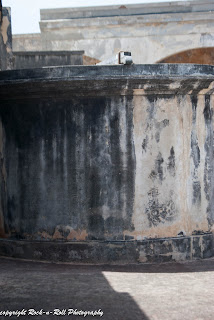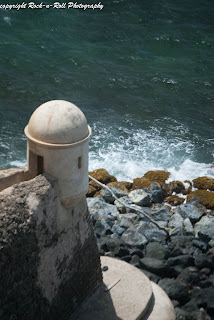Do you remember that family of siblings in High School with the older brother who was so popular? He was the president of the class, captain of the football team, and homecoming king. He was the tallest, best looking and most broad shouldered of the bunch. And then there was his younger brother. Not quite as tall or broad shouldered, not quite as popular or good looking. If you can smile to yourself and think back to that family, then you will have a picture of Castillo San Cristobal and El Morro, as well as their even smaller sibling Fortin San Juan De la Cruz, located across the Bay of San Juan.
The second of the Historic National Sites named as such in 1949, that showed the military readiness of the island's defenses, is located about a half mile down from El Morro. Castillo San Cristobal is a smaller version of El Morro. Not quite as many levels, not nearly as large and positioned on the coast but further back from the entrance to the bay it was considered to be a part of the first line of defense by the Spaniards. But it was also used as a prison or jail for law breakers who lived in Viejo San Juan. One of the interesting things about San Cristobal when you visit it that a bomb shelter was added to the Fort during WWII by the U.S. Army. Since this Fort as well as El Morro were both used by the military during WWII, the army ensured that troops stationed there would have the latest and best protections possible against enemy attack. A phenomena that you will notice through out your tours of the Fortresses.
As military improvements became available the improvements became apparent in the Forts. Even though this is most noticeable in San Cristobal with the addition of the bomb shelter which is now used as a gift store and offices for the Park Service, as you walk through the Fort many of the other changes and additions that were made over a time span of about 250 years are pointed out with signage.
One of the interesting features that we saw was the system of tunnels through out San Cristobal. The tunnels are at least six feet in height and width and allowed for troop movement unseen by the enemy. A big strategical advantage. I also noticed in San Cristobal that there were three wells inside the main plaza level that were the openings to very large underground cisterns. During the Forts building, the architect took into account the need for plenty of fresh water for those stationed there. We were told that the cistern/well system had a capacity of 780,000 gallons of fresh water. Much of that water was collected rainwater and in both San Cristobal and El Morro there is an elaborate system for collecting and then storing the water. Animals were not kept in San Cristobal so that the rain water would not be contaminated and there was a separate sewer system for the latrines that emptied directly out into the Bay. Fortunately, raw sewage being dumped directly out to the Bay no longer happens.
This fort like the other had a chapel, smaller and with an open air design. It is set in a corner of the main plaza with the alter under roof, we were told that the troops would stand or sit out in the open air of the plaza as an enclosed seating area was not part of the original design.
You can either visit El Morro first and take the free trolley to San Cristobal or start at San Cristobal and then move uphill to El Morro. The trolley runs continuously between the hours of 9 a.m. and 5 p.m. and most of the time seats are at a premium, especially on weekends.
I would recommend seeing San Cristobal if time permits, if not just remember the younger brother and allow yourself the option to go check out other things in Viejo San Juan. If you do decide to visit the Fort, entry cost is $3 or if you have thought ahead (not me) and saved your receipt from your prior visit to El Morro then the fee is reduced to $2. This works the same at El Morro, if you visit San Cristobal first and save your receipt your entry cost is reduced. The park ranger at the entrance will hand you a large full color brochure at each location. You will really only need one. The same brochure applies to all the Forts in San Juan. Also as San Cristobal is a smaller fortress, you can allow a less time. Perhaps an hour to an hour and a half should be sufficient.
If you care to take the trolley from San Cristobal the stop is across the street from the entrance to the Fortress and on the days we were in Old San Juan, there was a vendor selling bottled water for a $1 directly in front of the stop. There were also trash cans strategically positioned there as well. I tried to stay upwind of the trash can and was lucky enough to find a seat upwind while I waited for the trolley.
 |
| The walls of the fortress as viewed from the outside. |
 |
| This shows the Garita's placement on the outside seaward walls of San Cristobal. The tops of the walls have breaks in them for cannon placement. |
 |
| This Garita or Sentry Box is one of the oldest dating from the first construction of the fort. |
 |
| A view of Viejo San Juan from the ground defense level and beyond the town to the Bay. |
 |
| One of the tunnels of San Cristobal. |
 |
| The chapel under roof. This is where the alter is. |
 |
| Long guns in storage for the soldiers use. |
 |
| One of the wells that covered and accessed the cisterns underground. |
 |
| Officers quarters with a rudimentary transom for air circulation. |
 |
| The original tiles in the officers quarters. These were the only original Spanish tiles that I saw at either fortress. And this was all that was left. |
 |
| Views of the Fort and the Sentry box. There were much fewer Sentry boxes at San Cristobal than at El Morro. |
 |
| This was an opening in the walls that allowed for sentry duty and cannon. This is the view toward El Morro and away from old San Juan. |
 |
| The view toward old San Juan and away from El Morro. |
 |
| This was called the Devil's station because of its proximity to the sea and rocky shore. |
 |
| Sentry box which shows its age. It was originally covered in a lime based mortar which was white. The salt air, constant winds and sun have taken their toll. |
 |
| Part of the water collection system. Rain water run off ran through a closed system that eventually led it all underground to the large cisterns. |
 |
| A plaque which commemorates the designation as a National Historic Site for San Cristobal. |


No comments:
Post a Comment